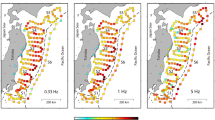Abstract
A problem in the use of ocean bottom seismometers is the difficulty in leveling the sensors while ensuring good coupling to the seafloor. We have investigated the coupling characteristics of the seismic sensors in the new ONR ocean bottom seismometer. In the deployable sensor package for that instrument, a three-component seismometer set is suspended on a 2-axis passive leveling gimbal and is immersed in a viscous fluid. We report tests, conducted in a seismic vault, comparing the output of a gimbaled seismometer set to that of a set rigidly coupled to the ground. Our results show that the degree to which the gimbaled set is coupled to ground motion is a function of the viscosity of the coupling fluid. The coherence between the two sensor sets is poor (<0.4) at some frequencies within the band of interest (0.15 to 20 Hz) and on some components when the viscosity of the coupling fluid is comparatively low (14 Pa-s or 0.16 kSt kinematic viscosity). In addition, the outputs of some components over portions of this frequency band are attenuated and are phase-shifted relative to the outputs of the set rigidly coupled to the ground. Coherence and phase response similarity improve as the viscosity of the coupling fluid is increased. With a coupling fluid viscosity of 980 Pa-s (10 kSt), coherence and phase agreement between the two sensor sets is good (>0.9) across nearly the entire band of interest on all three components. A simple analytical model of the gimbaled seismometer set as a damped, driven, compound-pendulum provides a basis for understanding the test results.
Similar content being viewed by others
References
Bookbinder, R. G., Hubbard, A. C., McDonald, W. G., and Pomeroy, P. W., 1978, Design of an Ocean Bottom Seismometer with Response from 25 Hz to 100 Seconds,Oceans 178, 510–515.
Byrne, D. A. and Inchinose, W., Jr., 1977, Ocean Bottom Seismometer Gimbal Systems,Exposure 5, No. 5, 1–7.
Duschenes, J. D., Barash, T. W., Mattaboni, P. J., and Solomon, S. C., 1981, On the Use of an Externally Deployed Geophone Package on an Ocean Bottom Seismometer,Mar. Geophys. Res. 4, 437–450.
Eguchi, T., Fujinawa, Y., Matsuzaki, T., and Aoyagi, M., 1986, New Pop-Up Type Ocean Bottom Seismometer,Mar. Geophys. Res. 8, 187–199.
Francis, T. J. G., Porter, I. T., Lane, R. D., Osborne, P. J., Pooley, J. E., and Tomkins, P. K., 1975, Ocean Bottom Seismograph,Mar. Geophys Res. 2 195–213.
Fyen, J., 1990, Diurnal and Seasonal Variations in the Microseismic Noise Level Observed at the NORESS Array,Phys. Earth Planet. Inter. 63, 252–268.
Jacobson, R. S., Dorman, L. M., Purdy, G. M., Schultz, A., and Solomon, S. C., 1991, New Ocean Bottom Seismometer Facilities Available for Use,Eos Trans. Amer. Geophys. Un. 72, 506, 515.
Johnson, R. V., II, Lister, C. R. B., and Lewis, B. T. R., 1977, A Direct Recording Ocean Bottom Seismometer,Mar. Geophys. Res. 3, 65–85.
Kirk, R. E., Whitmarsh, R. B., and Langford, J. J., 1982, A Three-Component Ocean Bottom Seismograph for Controlled Source and Earthquake Seismology,Mar. Geophys. Res. 5, 327–341.
Moore, R. D., Dorman, L. M., Huang, C., and Berliner, D. L., 1981, An Ocean Bottom, Microprocessor Based Seismometer,Mar. Geophys. Res. 4, 451–477.
Oppenheim, A. V. and Schafer, R. W., 1975,Digital Signal Processing Prentice-Hall, Englewood Cliffs, New Jersey, 585 pp.
Riedesel, M. A., Moore, R. D., and Orcutt, J. A., 1990, Limits of Sensitivity of Inertial Seismometers with Velocity Transducers and Electronic Amplifiers,Bull. Seismol. Soc. Amer. 80, 1725–1752.
Sutton, G. H. and Duennebier, F. K., 1987, Optimum Design of Ocean Bottom Seismometers,Mar. Geophys. Res. 9, 47–65.
Sutton, G. H., Kasahara, J., Ichinose, W. N., and Byrne, D. A., 1977, Ocean Bottom Seismograph Development at Hawaii Institute of Geophysics,Mar. Geophys. Res. 3 153–177.
Sutton, G. H., McDonald, W. G., Prentiss, D. D., and Thanos, S. N., 1965, Ocean-Bottom Seismic Observatories,Proc. IEEE 53 1909–1921.
Whitmarsh, R. B. and Lilwall, R. C., 1983, Ocean-Bottom Seismographs, inStructure and Development of the Greenland—Scotland Ridge Bott, M. H. P., Saxov, M., Talwani, M., and Thiede, J. (eds.), Plenum, New York, pp. 257–286.
Author information
Authors and Affiliations
Rights and permissions
About this article
Cite this article
Barash, T.W., Doll, C.G., Collins, J.A. et al. Quantitative evaluation of a passively leveled ocean bottom seismometer. Mar Geophys Res 16, 347–363 (1994). https://doi.org/10.1007/BF01203972
Received:
Accepted:
Issue Date:
DOI: https://doi.org/10.1007/BF01203972




